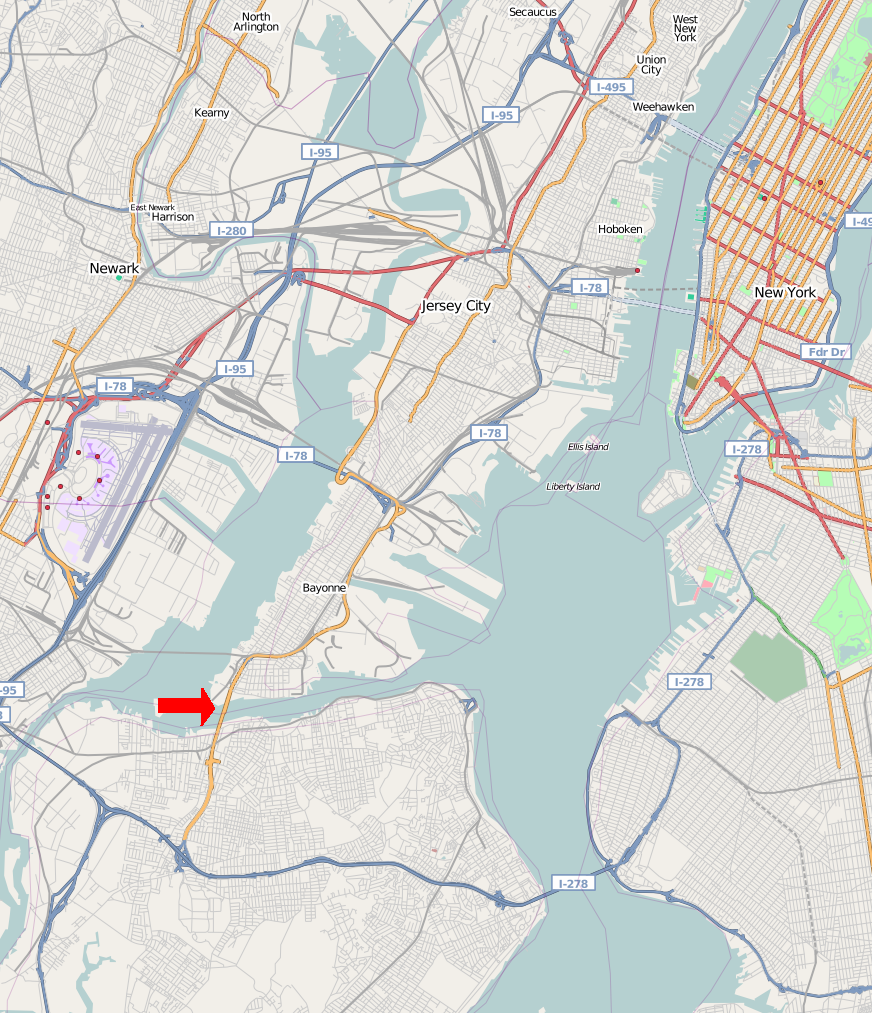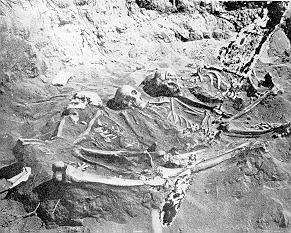|
Raritan (Native Americans)
The Raritan were two groups of Lenape people who lived around the lower Raritan RiverIves Goddard, "Delaware," p. 213. and the Raritan Bay, in what is now northeastern New Jersey, in the 16th century. Name The name ''Raritan'' likely came from one of the Delaware languages, Lenape languages (among the languages in the Algonquian languages, Algonquian language group), though there are a variety of interpretations as to its meaning. It may derive from ''Naraticong'' meaning "river beyond the island." ''Raritan'' is a Dutch pronunciation of ''wawitan'' or ''rarachons'', meaning "forked river" or "stream overflows". The first group known as the Raritan was also known as the Sanhicans. A second group, known as the Wiechquaeskecks, Wisquaskecks, Roaton, Raritanghe,David de Vries's Notes''Narratives of New Netherland'' p. 208. and Raritanoos settled the Raritan watershed area after the first departed. History 17th century The original Raritans, the Sanhicans, lived along Rari ... [...More Info...] [...Related Items...] OR: [Wikipedia] [Google] [Baidu] |
New Jersey
New Jersey is a U.S. state, state located in both the Mid-Atlantic States, Mid-Atlantic and Northeastern United States, Northeastern regions of the United States. Located at the geographic hub of the urban area, heavily urbanized Northeast megalopolis, it is bordered to the northwest, north, and northeast by New York (state), New York State; on its east, southeast, and south by the Atlantic Ocean; on its west by the Delaware River and Pennsylvania; and on its southwest by Delaware Bay and Delaware. At , New Jersey is the List of U.S. states and territories by area, fifth-smallest state in land area. According to a 2024 United States Census Bureau, U.S. Census Bureau estimate, it is the List of U.S. states and territories by population, 11th-most populous state, with over 9.5 million residents, its highest estimated count ever. The state capital is Trenton, New Jersey, Trenton, and the state's most populous city is Newark, New Jersey, Newark. New Jersey is the only U.S. stat ... [...More Info...] [...Related Items...] OR: [Wikipedia] [Google] [Baidu] |
Newark Bay
Newark Bay is a tidal bay at the confluence of the Passaic and Hackensack Rivers in northeastern New Jersey. It is home to the Port Newark-Elizabeth Marine Terminal, the largest container shipping facility in Port of New York and New Jersey, the second busiest in the United States. An estuary, it is periodically dredged to accommodate seafaring ships. Geography Newark Bay is rectangular, approximately long, varying in width from . It is enclosed on the west by the cities of Newark and Elizabeth, and on the east by Jersey City and Bayonne. At the south is Staten Island, New York and at the north Kearny Point and Droyer's Point mark the mouth of the Hackensack. Shooters Island is a bird sanctuary where the borders of Staten Island, Bayonne and Elizabeth meet at one point. The southern tip of Bergen Neck, known as Bergen Point, juts into the bay and lent its name to the former Bergen Point Lighthouse. Built offshore in 1849 it was demolished and replaced with a skel ... [...More Info...] [...Related Items...] OR: [Wikipedia] [Google] [Baidu] |
Navesink (Native Americans)
The Navesink, or Navisink, (or Nave Sinck) were a group of Lenape who inhabited the Raritan Bayshore near Sandy Hook and Mount Mitchill in eastern New Jersey in the United States. Their territory included the peninsula, as well as the highlands south of it, where they lived along its cliffs and creeks. Archeological artifacts have been found throughout this area. The Navesink shared the totem, a turtle, and spoke the same Lenape dialect, Unami, as their neighbors, the Raritan, and other groups such as the Hackensack and Tappan. Early European contact was in the 16th and 17th centuries. The explorer Henry Hudson, an English sea captain first had contact with the Navesink among Native Americans, as recorded in journals from his ship, the ''Halve Maen'' on September 3, 1609. When crew went off the ship, they were attacked by Navesink. John Colman was killed and was said to be buried at what is now called Coleman's Point. Cornelius Van Werckhoven, an investor in New Net ... [...More Info...] [...Related Items...] OR: [Wikipedia] [Google] [Baidu] |
Canarsee
The Canarsee (also Canarse and Canarsie) were a band of Munsee-speaking Lenape who inhabited the westernmost end of Long Island at the time the Dutch colonized New Amsterdam in the 1620s and 1630s. They are credited with selling the island of Manhattan to the Dutch, even though they only occupied its lower reaches, with the balance the seasonal hunting grounds of the Wecquaesgeek of the Wappinger people to the north."The $24 Swindle" Nathaniel Benchley, ''American Heritage'', 1959, Vol 11, Issue 1 The Canarsee were among the peoples who were conflated with other Long Island bands into a group called the , an aggregation which failed to recognize their linguistic differences and varying tribal affinities. Name ...
|
Wappinger
The Wappinger ( ) were an Eastern Algonquian Munsee-speaking Native American people from what is now southern New York and western Connecticut. At the time of first contact in the 17th century they were primarily based in what is now Dutchess County, New York, but their territory included the east bank of the Hudson in what became both Putnam and Westchester counties south to the western Bronx and northern Manhattan Island. To the east they reached to the Connecticut River Valley, and to the north the Roeliff Jansen Kill in southernmost Columbia County, New York, marked the end of their territory. Their nearest allies were the Mohican to the north, the Montaukett to the southeast on Long Island, and the remaining New England tribes to the east. Like the Lenape, the Wappinger were highly decentralized as a people. They formed numerous loosely associated bands that had established geographic territories. The Wequaesgeek, a Wappinger people living along the lower ... [...More Info...] [...Related Items...] OR: [Wikipedia] [Google] [Baidu] |
Hackensack (Native Americans)
Hackensack was the exonym given by the Dutch colonists to a band of the Lenape, or ''Lenni-Lenape'' ("original men"), a Native American tribe. The name is a Dutch derivation of the Lenape word for what is now the region of northeastern New Jersey along the Hudson and Hackensack rivers. While the Lenape people occupied much of the mid-Atlantic area, Europeans referred to small groups of native people by the names associated with the places where they lived. Territory and society The territory of the Hackensack was variously called Ack-kinkas-hacky, Achkinhenhcky, Achinigeu-hach, Ackingsah-sack, among other spellings (translated as "place of stony ground" or "mouth of a river") and included the areas around the Upper New York Bay, Newark Bay, Bergen Neck, the Meadowlands, and the Palisades. A phratry of the Lenape, the Hackensack spoke the Unami dialect, one of the two major dialects of the Lenape, or Delaware, languages, which were part of the Algonquian language family ... [...More Info...] [...Related Items...] OR: [Wikipedia] [Google] [Baidu] |
Burial Ridge
Ward's Point is the southernmost point in the U.S. state of New York and lies within Tottenville, Staten Island, New York City. It is located at the mouth of Arthur Kill, across from Perth Amboy, New Jersey, at the head of Raritan Bay. The site is part of modern-day Conference House Park. Ward's Point Conservation Area Ward's Point Conservation Area is a historic archaeological site and national historic district. The district encompasses nine contributing sites. It includes the property on which the Conference House sits. The Conference House was listed as a National Historic Landmark in 1966. The conservation area was specifically identified for preservation based on "the information it may provide on prehistoric and historic Indian subsistence and settlement on Staten Island." A number of prehistoric remains have been located on the site. ''See also:'' It was added to the National Register of Historic Places in 1982. Ward's Point Archeological Site Near Ward's Point ... [...More Info...] [...Related Items...] OR: [Wikipedia] [Google] [Baidu] |
Six Nations Of The Grand River
Six Nations (or Six Nations of the Grand River) is demographically the largest First Nations reserve in Canada. As of the end of 2017, it has a total of 27,276 members, 12,848 of whom live on the reserve. The six nations of the Iroquois Confederacy are the Mohawk, Cayuga, Onondaga, Oneida, Seneca and Tuscarora. Some Lenape (also known as Delaware) live in the territory as well. The Six Nations reserve is bordered by the County of Brant, Norfolk County, and Haldimand County, with a subsection reservation, the New Credit Reserve, located within its boundaries. The acreage at present covers some near the city of Brantford, Ontario. This represents approximately 8% of the original of land granted to the Six Nations by the 1784 Haldimand Proclamation. History Many of the Haudenosaunee people allied with the British during the American Revolutionary War, particularly warriors from the Mohawk, Cayuga, Onondaga and Seneca nations. Some warriors of the Oneida and Tuscarora also ... [...More Info...] [...Related Items...] OR: [Wikipedia] [Google] [Baidu] |
Delaware First Nation
The Delaware First Nation is a Lenape First Nation in southern Ontario and is a member nation of the Six Nations of the Grand River. Its reserves include the shared Glebe Farm 40B and Six Nations of the Grand River First Nation Six Nations (or Six Nations of the Grand River) is demographically the largest First Nations reserve in Canada. As of the end of 2017, it has a total of 27,276 members, 12,848 of whom live on the reserve. The six nations of the Iroquois Confederac ... reserves. References {{FirstNations-stub Lenape First Nations governments in Ontario Six Nations of the Grand River ... [...More Info...] [...Related Items...] OR: [Wikipedia] [Google] [Baidu] |
Moravian Of The Thames First Nation
Moravian 47 (Munsee: ''Náahii'', literally 'downstream', in contrast with Munsee-Delaware Nation, referred to as "Nalahii", meaning "upstream") is an Indian reserve located in Chatham-Kent, Ontario, with an area of . It is occupied by the Delaware Nation at Moraviantown First Nation (), a part of the Christian Munsee branch of the Lenape, and is commonly known as Moravian of the Thames reserve. The resident registered population is 457, with another 587 band members living off the reserve. A group of Munsee was converted to Christianity by missionaries of the Moravian Church in Pennsylvania; these persons and their descendants are known as the Christian Munsee. They moved to Ohio Country, under pressure from European settlers in the east. Vibrant Moravian Christian Indian settlements were established in Schoenbrunn, Gnadenhutten, Salem, Petquotting and Goshen. After many of those in Gnadenhutten and Salem were murdered by American colonial militia in the Gnadenhutten massac ... [...More Info...] [...Related Items...] OR: [Wikipedia] [Google] [Baidu] |
Delaware Nation
The Delaware Nation (), based in Anadarko, OklahomaDelaware Tribe regains federal recognition. ''NewsOk.'' 4 Aug 2009 (retrieved 5 August 2009) is one of three federally recognized tribes of Lenape, Delaware Indians in the United States, along with the Delaware Tribe of Indians, Delaware Indians based in Bartlesville, Oklahoma and the Stockbridge–Munsee Community of Wisconsin. Two Lenape First Nations are in Ontario, Canada. The Delaware Nation was also known as the Delaware Tribe of Western Oklahoma and was sometimes called the Absentee or Western Delaware. Government Delaware Nation had 2,255 enrolled citizens in the 2024 fiscal year. As of March 16, 2019, Delaware Nation membership was changed from minimum blood quantum of 1/8 blood to ...[...More Info...] [...Related Items...] OR: [Wikipedia] [Google] [Baidu] |
Delaware Tribe Of Indians
The Delaware Tribe of Indians, or the Eastern Delaware, based in Bartlesville, Oklahoma, is one of three federally recognized tribes of the Lenape people in the United States. The others are the Delaware Nation based in Anadarko, Oklahoma,Delaware Tribe regains federal recognition. ''NewsOk.'' 4 Aug 2009 (retrieved 5 August 2009) and the Stockbridge-Munsee Community of . More or Delaware people live in |





